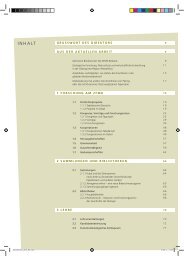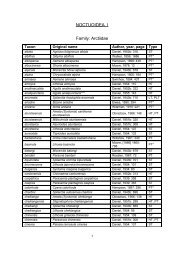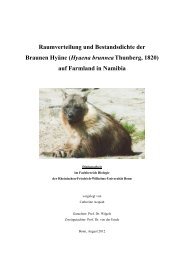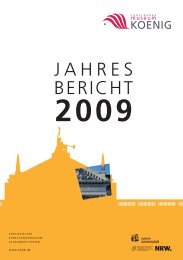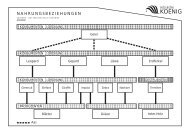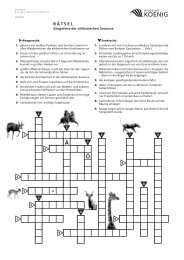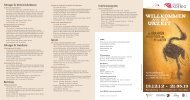Aliscore - Manual - Zoologisches Forschungsmuseum Alexander ...
Aliscore - Manual - Zoologisches Forschungsmuseum Alexander ...
Aliscore - Manual - Zoologisches Forschungsmuseum Alexander ...
You also want an ePaper? Increase the reach of your titles
YUMPU automatically turns print PDFs into web optimized ePapers that Google loves.
<strong>Aliscore</strong> - <strong>Manual</strong><br />
Bernhard Misof, 1 and Patrick Kück 2∗<br />
1 Biozentrum Grindel und <strong>Zoologisches</strong> Museum, University of Hamburg,<br />
Martin-Luther-King Platz 3, 20146 Hamburg, Germany<br />
2 <strong>Zoologisches</strong> <strong>Forschungsmuseum</strong> A.Koenig, Bonn,<br />
Adenauerallee 160, 53113 Bonn, Germany<br />
∗ E-mail: ali score@web.de<br />
6th February 2009
<strong>Aliscore</strong> - <strong>Manual</strong> 2<br />
Contents<br />
1 Introduction 3<br />
2 Usage/Options 3<br />
2.1 -h option . . . . . . . . . . . . . . . . . . . . . . . . . . . . . . . . . . . . . 4<br />
2.2 -N option . . . . . . . . . . . . . . . . . . . . . . . . . . . . . . . . . . . . 4<br />
2.3 -w option . . . . . . . . . . . . . . . . . . . . . . . . . . . . . . . . . . . . 4<br />
2.4 -r option . . . . . . . . . . . . . . . . . . . . . . . . . . . . . . . . . . . . . 4<br />
2.5 -t option . . . . . . . . . . . . . . . . . . . . . . . . . . . . . . . . . . . . . 5<br />
2.6 -l option . . . . . . . . . . . . . . . . . . . . . . . . . . . . . . . . . . . . . 5<br />
2.7 -s option . . . . . . . . . . . . . . . . . . . . . . . . . . . . . . . . . . . . . 5<br />
2.8 -o option . . . . . . . . . . . . . . . . . . . . . . . . . . . . . . . . . . . . . 5<br />
3 Internals 5<br />
3.1 Input . . . . . . . . . . . . . . . . . . . . . . . . . . . . . . . . . . . . . . . 5<br />
3.2 Reading FASTA file . . . . . . . . . . . . . . . . . . . . . . . . . . . . . . . 6<br />
3.3 Reading data type and scoring matrix . . . . . . . . . . . . . . . . . . . . . 6<br />
3.4 Checks for mutiple identical sequences . . . . . . . . . . . . . . . . . . . . 7<br />
3.5 Checking variability . . . . . . . . . . . . . . . . . . . . . . . . . . . . . . . 7<br />
3.6 Scoring of randomly selected sequence pairs . . . . . . . . . . . . . . . . . 7<br />
3.6.1 Scoring . . . . . . . . . . . . . . . . . . . . . . . . . . . . . . . . . . 7<br />
3.7 Scoring using tree based selection of pairwise comparisons . . . . . . . . . 7<br />
3.7.1 Reading Tree . . . . . . . . . . . . . . . . . . . . . . . . . . . . . . 8<br />
3.7.2 Removing potentially identical taxa . . . . . . . . . . . . . . . . . . 8<br />
3.8 Generation of Consensus Profiles . . . . . . . . . . . . . . . . . . . . . . . 8<br />
4 Copyright 8
<strong>Aliscore</strong> - <strong>Manual</strong> 3<br />
1 Introduction<br />
<strong>Aliscore</strong> is designed to filter alignment ambiguous or randomly similar sites in multiple<br />
sequence alignments (MSA). It does not generate a generic alignment, this must be provided<br />
by the user. <strong>Aliscore</strong> reads exclusively alignments in FASTA format independently<br />
of suffices (.fas .txt .fts etc.). <strong>Aliscore</strong> reads the alignment and generates a hash of these<br />
sequences with taxon names as keys and simple sequence arrays as values. It works on<br />
these hash elements and uses these hash elements as the basic data. <strong>Aliscore</strong> tolerates<br />
newlines in sequences but not in taxon names. Sequences must be of similar length! <strong>Aliscore</strong><br />
can not read sequences in interleaved format, but this does not correspond to a plain<br />
fasta file anyway. Blanks in sequences are ignored, any other sign in sequences except<br />
for these covered by the universal DNA/RNA code will chock the program. Ambiguities<br />
are understood, as are indels. Kapital or small letters are equally good as input and can<br />
be used interchangeably, RNA and DNA sequences can be used in one alignment, RNA<br />
sequences are translated into DNA sequences. <strong>Aliscore</strong> works on WindowsPCs, Macs and<br />
Linux mashines, but was written on Linux. If input files are coming from Windows make<br />
sure CRFL feeds are removed. <strong>Aliscore</strong> tries to remove them, but my not succeed in every<br />
instance. Taxon names must only include alphanumeric signs, underscores ( ) and blanks,<br />
everything else might chock the program. <strong>Aliscore</strong> will issue an error prompt and die if<br />
any non-alphanumeric sign is encountered in taxon names. If used with the outgroup<br />
option avoid blanks in names as this might lead to erroneous recognition of taxon names.<br />
<strong>Aliscore</strong> will write results into its own folder. it will produce two files, one file with the<br />
consensus Profile, and one file with a list of characters with negative scores in this profile.<br />
Example of an input file:<br />
>Podura aquatica 18S 1<br />
aaagtctgtgacgttgtacggact<br />
gcgtgtgcagctgtgacgggcgcc<br />
>Sminthurus sp<br />
autgctugccguuugaucgugugc<br />
uuggacugcgucgatcguugcgcg<br />
2 Usage/Options<br />
For using <strong>Aliscore</strong> open the terminal of your run system, move through your directory<br />
path to the <strong>Aliscore</strong> including folder and type the name of your <strong>Aliscore</strong> version, followed<br />
by a blank and your demand options, all in one row.<br />
For example:<br />
C:\Folder of <strong>Aliscore</strong>> Name of <strong>Aliscore</strong> Version.pl -i inputfile.fas<br />
<strong>Aliscore</strong>s knows several options, it chocks if an unknown option is encountered. Make<br />
sure you write the input options correctly, for example “-w 4“ and not “-w4“ or “-w 4“,<br />
etc., likewise do not (!) use “-in infile“, or “in infile“ or “-i infile“; these are all wrong
<strong>Aliscore</strong> - <strong>Manual</strong> 4<br />
input formats and will cause the program to die. It will still try to open an “n infile“ or<br />
“ infile“ which is hopefully not present, it will also tell you this.<br />
2.1 -h option<br />
-h option: with the -h option <strong>Aliscore</strong> delivers a short introduction about usage format<br />
and adaptable option codes. For detailed help on options type “help“, followed by the<br />
demand option code.<br />
For example:<br />
C:\Folder of <strong>Aliscore</strong>> Name of <strong>Aliscore</strong> Version.pl help -i<br />
For deeper explanations about output format, scoring scheme and commands type as<br />
the case maybe “help -output“, “help -scoring“ or “help -commands“.<br />
2.2 -N option<br />
-N option: without invoking the -N option gaps are treated as 5th character. With the<br />
-N option invoked gaps are treated as ambiguous character. Leading and tailing gaps of<br />
sequences are always interpreted as ambiguous characters with and without the -N option.<br />
Interpreting gaps as ambiguous characters results in a loss of long indel sections consistently<br />
found in the majority of taxa. This means that well aligned expansion segments<br />
in rDNA sequences, which are not present in other taxa will be lost, if not commonly<br />
found in the MSA. Interpreting gaps as 5th character interprets stretches of indels as well<br />
aligned sections.<br />
2.3 -w option<br />
-w # option: without invoking this -w # option, <strong>Aliscore</strong> will use the default window size<br />
of 6 for the sliding window. You may choose any other window size, smaller or larger,<br />
but it does not make sense to choose something smaller then 4. If you vote for a much<br />
larger window size then 6, <strong>Aliscore</strong> will become successively blind for small stretches of<br />
randomly similar sections. (See paper on <strong>Aliscore</strong> performance). If you vote for window<br />
size
<strong>Aliscore</strong> - <strong>Manual</strong> 5<br />
2.5 -t option<br />
-t “treefile“ option: -t must be used with a tree file in Newick format, rooted or unrooted.<br />
The tree file should be in the same folder as the sequence file (not mandatory). If there<br />
are more than one tree in the tree file, only the first one will be read, all other trees<br />
will be ignored. The tree file does not contain any polytomic splits. Otherwise <strong>Aliscore</strong><br />
breaks up yet. <strong>Aliscore</strong> will read the tree and store as a hash with node levels as keys<br />
and taxa as values for each node. <strong>Aliscore</strong>s uses this tree to work through the MSA<br />
from tips to bottom of tree. First, sister groups of terminal taxa are identified (node<br />
lists, level 1 as key) and compared, these taxa are then replaced by consensus sequences<br />
using the ambiguity code. Consensus sequences represent now the new set of terminal<br />
taxa with which <strong>Aliscore</strong> proceeds. This process is repeated until every possible pair of<br />
sequences within the tree is evaluated. Make sure that your tree does not contain CRFL<br />
from Windows if working on Linux!<br />
2.6 -l option<br />
-l # option: -l can be used to restrict iterating through the tree to a specific node level,<br />
specified with the argument at the -l option. If -l 1 is used only primary sister group<br />
relationships are used to infer the consensus profile. If there are less node levels then<br />
arguments, <strong>Aliscore</strong> iterates through the tree and stops.<br />
2.7 -s option<br />
-s option: -s option can be used to generate a strict profile from all single comparisons.<br />
This profile will be very conservative because it scores every site as negative which exhibits<br />
a negative score in one single profile already. This option does not make to much sense,<br />
do not use it on purpose!<br />
2.8 -o option<br />
-o “taxon,taxon,..“ option: the -o option is used with a list of taxa separated by commatas.<br />
These taxa will be compared with all other taxa not in this list, but not with each other.<br />
It can be used to assess the range of randomness between outgroup taxa and ingroup<br />
taxa, or between every two groups of interest, if the alignment is restricted to ingroup<br />
taxa only before analysis.<br />
3 Internals<br />
Details and comments are given in order of its appearance in code.<br />
3.1 Input<br />
Input Arguments are collected into a 1-dimensional array and grep is used to retrieve<br />
options plus arguments; white spaces are cleaned off, and array is created by splitting<br />
input string at -; If you use taxon names with white spaces in -o option you might run<br />
into problems.
<strong>Aliscore</strong> - <strong>Manual</strong> 6<br />
For example:<br />
our ( $ f i l e )=grep /ˆ i .+/ ,@INPUT; $ f i l e =˜s /(ˆ i ) / / ;<br />
3.2 Reading FASTA file<br />
Fasta file is read and stored as a hash with taxon names as keys and references to sequence<br />
arrays as values. Sequences are stored as flat list, each position constituting an element.<br />
Only references to these hash elements are returned from the subroutine. The reference<br />
to the hash is used as a global variable indicated by “our“, only the file name is used as<br />
argument for the subroutine to open and read the file; will die if file has not bee found.<br />
<strong>Aliscore</strong> understands DNA ambiguity code, there is no need to replaces these. <strong>Aliscore</strong><br />
does not accept any sign except letters and indels in sequences. It will die if anything else<br />
is encountered in sequences.<br />
Command:<br />
our ( $ref FASTA)=Alignment alpha : : readFASTA simple ( $ f i l e ) ;<br />
number of taxa and taxon names are collected into an array for later comparison <strong>Aliscore</strong><br />
attempts to estimate the data type, either nucleotide or amino acid data. <strong>Aliscore</strong><br />
considers sequences with an ACTG content of > 0.8 (without counting indels and N)<br />
as nucleotide sequences, if less then 0.8 as amino acid data. It estimates data property<br />
from every sequence, if two sequences are considered of different data type, <strong>Aliscore</strong> stops.<br />
<strong>Aliscore</strong> might stop if a single nucleotide sequence contains more then 0.2 ambiguities. In<br />
almost every case, <strong>Aliscore</strong> will correctly estimate data type, if it does not, it will stop<br />
and report on the problem. If the data contains sequences of more then 0.2 ambiguities, it<br />
might be advisable to recode ambiguities as N’s or remove the particular sequence. RNA<br />
sequences will be recoded to DNA sequences. Nucleotide data can be a mix of RNA/DNA<br />
data.<br />
3.3 Reading data type and scoring matrix<br />
Reads data type and generates accordingly scoring matrix. In case of nucleotide data, the<br />
scoring matrix is a simple match mismatch scoring matrix, in case of ambiguous characters<br />
the mismatch is optimistically interpreted. If indels are considered 5th charaters, they are<br />
scored in a mismatch/match pattern. A BLOSUM62 is used for the amino acid scoring<br />
with indels and X scoring 0. For aminoacid scoring, a Monte Carlo approach is used to<br />
generate a threshhold value, given the actual window size and aminoacid composition of<br />
the data.<br />
The -e option refers to special aminoacid scoring. if -e option is used, matching indels<br />
are penalized but not aminoacid and indel matches. This favors sections of the alignment,<br />
in which aminoacids are indeed present, but not dominating the signal. A biological<br />
interpretation is not straightforward, but given data from EST projects or phylogenomic<br />
data, in which often parts of genes are missing, ALISCORE is less restrictive and favors<br />
information from aminoacid data.
<strong>Aliscore</strong> - <strong>Manual</strong> 7<br />
3.4 Checks for mutiple identical sequences<br />
<strong>Aliscore</strong> checks for potential identical sequences. It considers sequences which can be<br />
a subset of another longer sequence, ignoring N, potentially identical. Only the longer<br />
sequence, not considering N’s, will be retained for the analyses. If there are mutiple<br />
potentially identical sequences, only the one with the most inclusive sequence will be<br />
retained. <strong>Aliscore</strong> does not concatenate sequences, even if potentially profitable. Results<br />
are reported to the terminal.<br />
3.5 Checking variability<br />
Checks for invariant sections across the alignment with an extension of >w+2 (w window<br />
size). Reports these sections and places information as an argument into subroutine later.<br />
This step improves speed, because only variable sections are actually scored for random<br />
similarity. A simple iteration through all sequence arrays is used to check variability of<br />
sites. A @temp array is used to create the list of variable sections, results are reported to<br />
terminal<br />
3.6 Scoring of randomly selected sequence pairs<br />
The code reads the $random parameter and if defined with a number, which should have<br />
happened in any case except for the situation where the -t option and the -l option was<br />
evoked starts the random selection process. It first generates al possible pairs from the list<br />
of taxon names. It then checks whether the -o option was provided with an argument, if<br />
this is the case it fills a pairs list with all comparisons between outgroup taxa and ingroup<br />
taxa, if the -o option was not provided with an argument, it checks the argument of the<br />
-r option and selects as many random unique pairs from the list of all possible pairs. If<br />
the argument of -r was too large it stops when all possible pairs are included.<br />
3.6.1 Scoring<br />
For each entry in the pairs list, it uses the two taxon names to look in the data hash for<br />
both sequences and uses the scoring type, flat list of variable characters and both sequence<br />
references as arguments. All arguments are provided as references. The scoring profile is<br />
returned as a reference. Description of the scoring process see Alignment alpha.pm. The<br />
list of arguments must be in order, reference to the scoring type must be first.<br />
3.7 Scoring using tree based selection of pairwise comparisons<br />
A user provided tree, rooted or unrooted, but fully dichotomous must be provided by<br />
the user. This tree is used for selection of sequence pairs. First, terminal sister taxa are<br />
compared, then these sequence pairs are replace by one consensus sequence. Consequently,<br />
the next set of terminal sequence pairs might contain consensus sequences and primary<br />
sequences. Consensus sequences make uses of the full ambiguity code to represent every<br />
difference in primary parent sequences. The scoring stops when the last sequence pair has<br />
been analysed.
<strong>Aliscore</strong> - <strong>Manual</strong> 8<br />
3.7.1 Reading Tree<br />
Tree must be in Newick format. Be careful, PAUP saves trees with basal polytomy<br />
as default. If these trees are used, <strong>Aliscore</strong> breaks up without an error message yet.<br />
Save trees without basal polytomies in PAUP and everything will be fine. Check set<br />
options in PAUP! You can use rooted trees, either rooted in PAUP or any other software<br />
package, and everything should be fine. Take care to check taxon names in trees, because<br />
only if these names correspond exactly (!) to names in sequence files, scoring will be<br />
performed. <strong>Aliscore</strong> will have its own tree reconstruction routine soon, to avoid problems<br />
of incongruent taxon names and polytomies.<br />
3.7.2 Removing potentially identical taxa<br />
Similarly to random pair selection, <strong>Aliscore</strong> removes potentially identical sequences in<br />
tree base selection of sequence pairs.<br />
3.8 Generation of Consensus Profiles<br />
From the collection of single profiles a consensus profile is generated. The consensus profile<br />
consists of medians for each site derived from site scores of all single profiles. It is thus a<br />
consensus representation of the situation in single profiles. <strong>Aliscore</strong> generates a List of all<br />
characters of the consensus profile below the 0 - base line. This list is written into a list<br />
file. Additionally, <strong>Aliscore</strong> writes a profile file in which three columns are written. First<br />
column, an enumeration of positions, second column sites with positive consensus values<br />
and third column sites with negative consensus values. Alternative consensus techniques<br />
would be conceivable, but the median certainly reflects the dominating mode among single<br />
profiles. Single profiles are collected into a temporary array, before a consensus profile<br />
will be generated. If the number of taxa > 200 and/or length of sequences > 8000 the<br />
process might crash because of RAM limits. This must be corrected in the near future,<br />
to avoid problems with very large data.<br />
4 Copyright<br />
c○by Bernhard Misof and Patrick Kück, Feburary 2008



